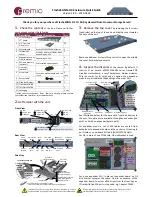
Removing a cooling fan.................................................................................................................................................87
Installing a cooling fan................................................................................................................................................... 88
System memory guidelines...........................................................................................................................................89
General memory module installation guidelines......................................................................................................... 90
NVDIMM-N memory module installation guidelines ................................................................................................. 91
DCPMM installation guidelines ................................................................................................................................... 94
Mode-specific guidelines.............................................................................................................................................. 96
Removing a memory module........................................................................................................................................99
Installing a memory module.........................................................................................................................................100
Removing the NVDIMM-N battery............................................................................................................................ 101
Installing the NVDIMM-N battery.............................................................................................................................. 102
Removing a processor and heat sink module........................................................................................................... 102
Removing the processor from the processor and heat sink module.....................................................................103
Installing the processor into a processor and heat sink module.............................................................................105
Installing a processor and heat sink module..............................................................................................................107
Expansion bus specifications...................................................................................................................................... 108
Removing an expansion card riser.............................................................................................................................. 113
Installing an expansion card riser................................................................................................................................ 115
Removing expansion card from the expansion card riser........................................................................................ 117
Installing an expansion card into expansion card riser.............................................................................................120
Removing the M.2 SSD module................................................................................................................................. 122
Installing the M.2 SSD module....................................................................................................................................123
Removing the optional IDSDM or vFlash card..........................................................................................................124
Installing optional IDSDM or vFlash card...................................................................................................................125
Removing the MicroSD card...................................................................................................................................... 126
Installing the MicroSD card......................................................................................................................................... 127
Removing the network daughter card...................................................................................................................... 128
Installing the network daughter card.........................................................................................................................129
Removing the integrated storage controller card....................................................................................................130
Installing the integrated storage controller card....................................................................................................... 131
Backplane details..........................................................................................................................................................133
Removing the backplane cover.................................................................................................................................. 134
Installing the backplane............................................................................................................................................... 134
Removing the 2.5 inch drive rear backplane............................................................................................................ 135
Installing the 2.5 inch drive rear backplane...............................................................................................................136
Cable routing...................................................................................................................................................................... 138
SAS expander card............................................................................................................................................................ 142
Contents
5






































